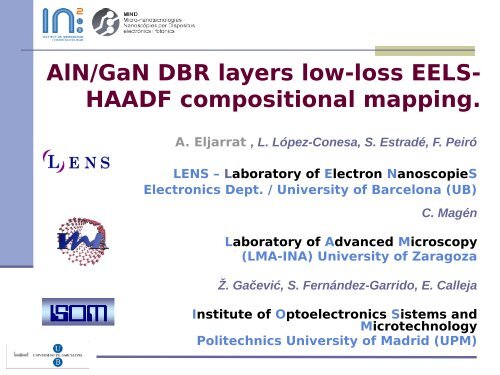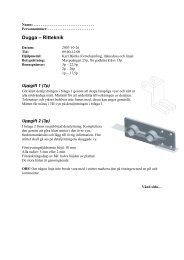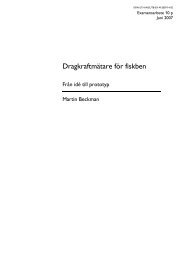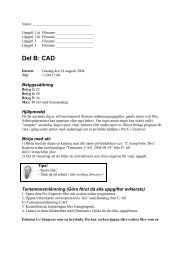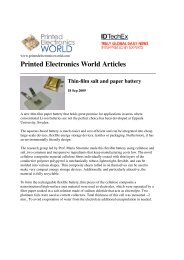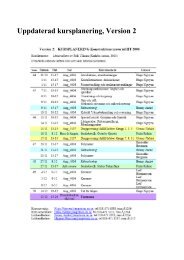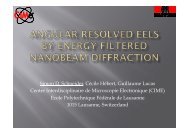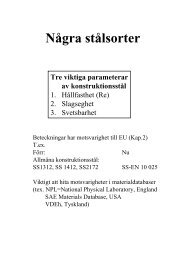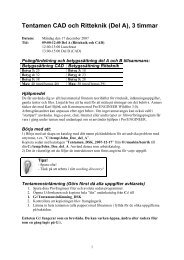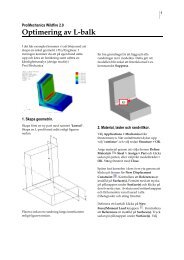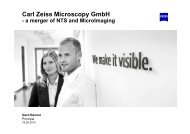AlN/GaN DBR layers low-loss EELS- HAADF compositional mapping.
AlN/GaN DBR layers low-loss EELS- HAADF compositional mapping.
AlN/GaN DBR layers low-loss EELS- HAADF compositional mapping.
Create successful ePaper yourself
Turn your PDF publications into a flip-book with our unique Google optimized e-Paper software.
<strong>AlN</strong>/<strong>GaN</strong> <strong>DBR</strong> <strong>layers</strong> <strong>low</strong>-<strong>loss</strong> <strong>EELS</strong>-<strong>HAADF</strong> <strong>compositional</strong> <strong>mapping</strong>.A. Eljarrat , L. López-Conesa, S. Estradé, F. PeiróLENS – Laboratory of Electron NanoscopieSElectronics Dept. / University of Barcelona (UB)C. MagénLaboratory of Advanced Microscopy(LMA-INA) University of ZaragozaŽ. Gačević, S. Fernández-Garrido, E. CallejaInstitute of Optoelectronics Sistems andMicrotechnologyPolitechnics University of Madrid (UPM)
OUTLINE●●INTERESTOptoelectronic devicePrevious studiesCHARACTERIZATION I●●●CHARACTERIZATION II(V)<strong>EELS</strong>Peak AnalysisHyperspectral ImagingCONCLUSIONS●Reflectivity●X-Ray Diffraction●STEM-<strong>HAADF</strong>
INTERESTSAMPLES: <strong>AlN</strong>/<strong>GaN</strong> multilayer structure in<strong>DBR</strong> configuration, for novel resonantcavity devices applications:●●●Resonant cavity LED’sVCSELsRefractive index●N<strong>AlN</strong> = 2.08, n<strong>GaN</strong> = 2.520 period, ~ 90nm each, crack-free multi<strong>layers</strong>tack. The composition is unknown, but pure<strong>AlN</strong> and <strong>GaN</strong> semiperiods are expected.Pair of bright field (BF, left) and darkfield (DF right) STEM-<strong>HAADF</strong> of thewhole structure.GROWTH TECHNIQUE: Plasma assisted Molecular Beam EpitaxyGrown on <strong>GaN</strong>/sapphire commercial template (Lumilog)Growth temperature for both semiperiods: @ 720 ºCGa used as surfactant. No growth interruptions employed.
RIBER Compact 21 MBE System.INTEREST
State of the art of <strong>AlN</strong>/<strong>GaN</strong> <strong>DBR</strong>Ž. Gačević, PhD Thesis (2012)
State of the art of <strong>AlN</strong>/<strong>GaN</strong> <strong>DBR</strong>
State of the art of <strong>AlN</strong>/<strong>GaN</strong> <strong>DBR</strong>
State of the art of <strong>AlN</strong>/<strong>GaN</strong> <strong>DBR</strong>
State of the art of <strong>AlN</strong>/<strong>GaN</strong> <strong>DBR</strong>
State of the art of <strong>AlN</strong>/<strong>GaN</strong> <strong>DBR</strong>
State of the art of <strong>AlN</strong>/<strong>GaN</strong> <strong>DBR</strong>
State of the art of <strong>AlN</strong>/<strong>GaN</strong> <strong>DBR</strong>
OUTLINE●●INTERESTOptoelectronic devicePrevious studiesCHARACTERIZATION I●●●CHARACTERIZATION II(V)<strong>EELS</strong>Peak AnalysisHyperspectral ImagingCONCLUSIONS●Reflectivity●X-Ray Diffraction●STEM-<strong>HAADF</strong>
Optical characterisationJASCO UV-Vis V-630spectrophotometerReflectivityspectra obtainedvia directmeasurements@400 nmPeak reflectivitiesbe<strong>low</strong> thetheoreticallyexpected values
XRD-RSM characterizationX'Pert PRO PANalytical XRD system1D w/2θ scan shows <strong>GaN</strong>substrate peak, as well as<strong>GaN</strong> and <strong>AlN</strong> <strong>DBR</strong> peaks.Many satellite peaks confirm the high periodicity of the structure.Super-lattice period 90 nm long, in excellent agreement with thenominal thickness of the In<strong>AlN</strong>/<strong>GaN</strong> bilayer.
XRD-RSM characterizationThe analysis of the[10-15] RSM revealsthat the ~ 2.5 % latticemismatch betweenboth binaries hasbeen partially redistributed:<strong>GaN</strong> iscompressively inplanestrained (∆a/a <strong>GaN</strong>~ -1%) while <strong>AlN</strong> isunder tensile in-planestress (∆a/a <strong>AlN</strong>~ 1.2%).
XRD-RSM characterizationQUESTIONSn Origin of <strong>low</strong>reflectivity?n Remaining latticemismatch?The analysis of the[10-15] RSM revealsthat the ~ 2.5 % latticemismatch betweenboth binaries hasbeen partially redistributed:<strong>GaN</strong> iscompressively inplanestrained (∆a/a <strong>GaN</strong>~ -1%) while <strong>AlN</strong> isunder tensile in-planestress (∆a/a <strong>AlN</strong>~ 1.2%).1+1.2 = 2.2 … ¡ ~ 0.3 % lattice mismatch remains (i.e. 0.01 Å) !
STEM-<strong>HAADF</strong> CharacterizationZ contrast images(darker = lighter)from <strong>HAADF</strong> modein the JEOL J2010F(S)TEM operated @200 kV show thestructure:- Crack-free, highlyperiodical structure:Periods are stablefor several microns.- 4-layer periodicsub-structure.Allegedly, Al<strong>GaN</strong> 1,<strong>GaN</strong>, Al<strong>GaN</strong> 2 and<strong>AlN</strong> <strong>layers</strong>.
STEM-<strong>HAADF</strong> CharacterizationLow <strong>loss</strong> spectrum lines in the Jeol @ CCiT (UB).
STEM-<strong>HAADF</strong> CharacterizationHIGHER RESOLUTIONWOULD BE HELPFULIN THIS CASE.
OUTLINE●●INTERESTOptoelectronic devicePrevious studiesCHARACTERIZATION I●●●CHARACTERIZATION II(V)<strong>EELS</strong>Peak AnalysisHyperspectral ImagingCONCLUSIONS●Reflectivity●X-Ray Diffraction●STEM-<strong>HAADF</strong>
<strong>HAADF</strong>-<strong>EELS</strong> Characterization2 <strong>HAADF</strong>images andAn EELspectrumProbe-corrected FEI Titan (S)TEM,equipped with Wien filter monochromator@ INA, Zaragoza.
(V)<strong>EELS</strong> in the STEMSTEM @ LMA-INA(Zaragoza)E0 = 300 kV, β = 17 mradAberration correctedMonochromatorEnergy dispersion0.02 eV/channel
Peak analysis: ZLPPosition and with of the peaks is obtained through non-linear (available shapes forpeaks in the literature like Gaussian, Lorentzian … and combinations) fittingroutines.
Peak analysis: ZLPZLP position and widthis measured, and usedto calibrate the spectra.ZLP Broadens throughthe interfaces.
Peak analysis: PlasmonThe Plasmon peak can givechemical and structuralinformation!Ep <strong>GaN</strong> =19.4eV,Ep <strong>AlN</strong> =21.3eVThe techniques used along with this image can befound in: A.Eljarrat et al. Microscopy andMicroanalysis, accepted 2012.
<strong>HAADF</strong> + <strong>EELS</strong>,Simulation + Vegard LawLeft image compares experimental <strong>HAADF</strong> intensity with a TEM-SIMsimulation (The atomic model was deigned using RHODIUS software)*.Right image is the result of applying Vegard's law to the determinedplasmon position though one period.Al<strong>GaN</strong> stoichiometric composition is confirmed!*Bibliographic references at the end.
Hyperspectral imagingof anomalous segregationsThe “spectrum image” is made ofspatially localized EEL spectra.See the schematical illustrationjust be<strong>low</strong> (Not actual data:borrowed from ENC Mills et al. J.Cereal Sci. APL 41 (2005) 193)We can map properties in imagesmade with spatially localized <strong>EELS</strong>.Typical tasks to be performed inone spectrum are described. Thencalculations run in a 2D patch.
Hyperspectral imagingof anomalous segregationsSpectral <strong>mapping</strong> is performed almost real-time throughour specialized Matlab/Octave scripts.Some examples of<strong>mapping</strong>properties usinglocalized spectra.
Hyperspectral imagingof anomalous segregationsHuge number of data: Theimage be<strong>low</strong> contains 30x286spatially localyzed spectra with2048 channels each.Almost impossible to analyze by“brute force” alone in astandard PC !
Hyperspectral imagingof anomalous segregationsYet all thesemaps havebeenpreparedwith astandard PC,and therelatedcalculationscan betweaked andrepeated inminutestime (if notseconds)
Hyperspectral imagingof anomalous segregations
Hyperspectral imagingof anomalous segregations
OUTLINE●●INTERESTOptoelectronic devicePrevious studiesCHARACTERIZATION I●●●CHARACTERIZATION II(V)<strong>EELS</strong>Peak AnalysisHyperspectral ImagingCONCLUSIONS●Reflectivity●X-Ray Diffraction●STEM-<strong>HAADF</strong>
ConclusionsStructural characterization:10-15-50-15 nm → Al<strong>GaN</strong>1-<strong>GaN</strong>-Al<strong>GaN</strong>2-<strong>AlN</strong>AlδGa(1-δ)N → δ(x) profiles and images.Anomalous segregationsMaterial info.:Islands of metallic AluminumPeak FWHM <strong>mapping</strong> → Crystallinityt/λ behavior with respect to Z
ConclusionsStructural characterization:10-15-50-15 nm → Al<strong>GaN</strong>1-<strong>GaN</strong>-Al<strong>GaN</strong>2-<strong>AlN</strong>AlδGa(1-δ)N → δ(x) profiles and images.Anomalous QUESTIONS segregationsn Origin of <strong>low</strong>Material info.:reflectivity?Islands n of Remaining metallic Aluminum latticePeak FWHM mismatch? <strong>mapping</strong> → Crystallinityt/λ behavior with respect to Z
Acknowledgements§ Scientific and Technological Center(CCiT-UB) TEM facilities atUniversity of Barcelona and (LMA-INA) at University of Zaragoza§ NANOARACAT: Aragon andCatalunya Governments agreementin Nanoscience and Nanotechnology§ Spanish Research ProgramCONSOLIDER (CSD2009-0013):IMAGINE: Materials at Sub-Angstrom resolution§ Spanish Research ProgramMAT2010-16407, SOLEMN, SOLutionthrough Electron Microscopy forNanostructured Materials
BibliographySampleH. Ng et al. APL 76 (2000) 20B. Heying et al. JAP 88 (2000) 4G. Koblmueller et al. APL 91 (2007) & JAP 93 (2003) 2P. Boguslawski et al. PRB 61 (2000) 16M. Benaissa et al. APL 95 (2009)AnalysisZ. Gacevic et al. JAP 108 (2010) 113117R.F. Egerton, Rep. Mod. Phys. 72 (2009) 016502SimulationJ. Perez-Omil, Ph.D. Thesis, UCA (1994)S.Bernal, UM 72 (1998) 135
http://www.lens.el.ub.esTHANK YOU FOR YOURATTENTION!aeljarrat@el.ub.edu


